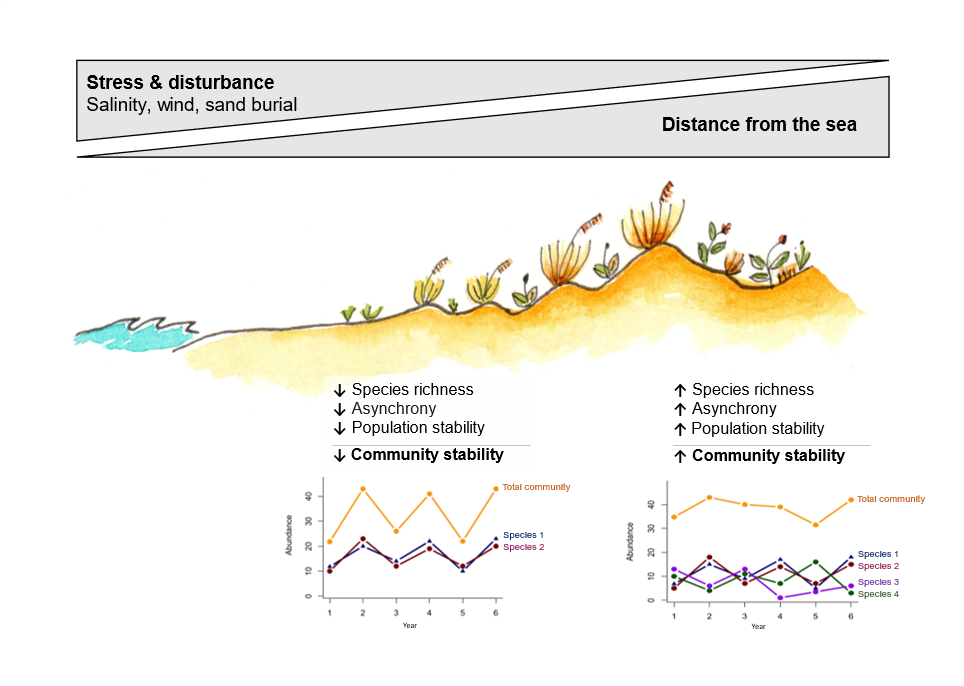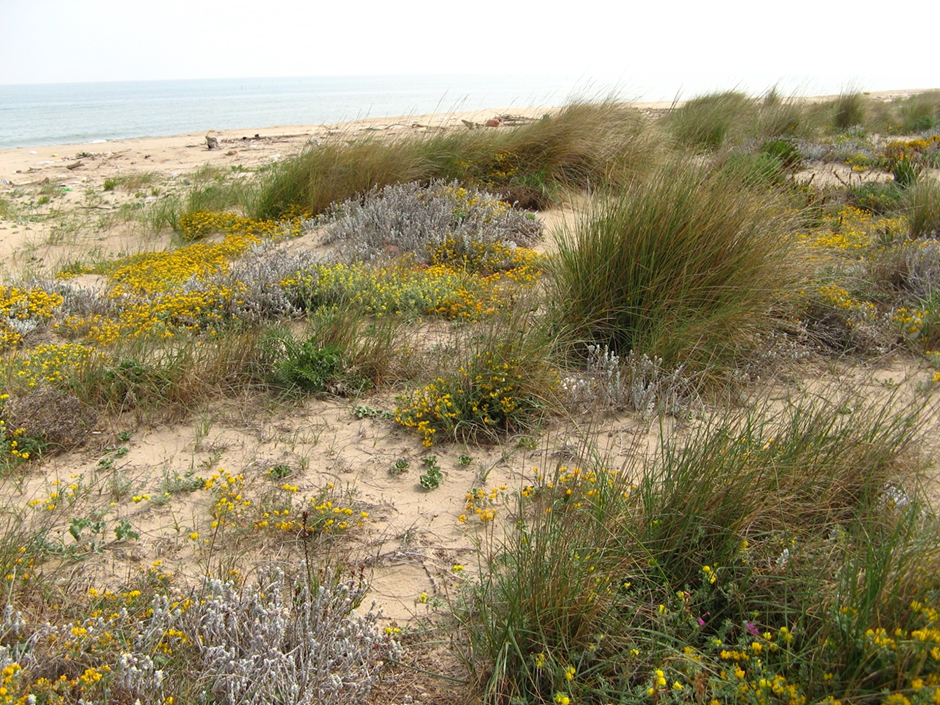|
Getting your Trinity Audio player ready...
|
Greta la Bella discusses her recent article: Drivers of plant community (in)stability along a sea-inland gradient. Read on to find out about the species ecological characteristics that promote the stability of coastal dune ecosystems:
————————————————————————————————————————————–
❓ What is stability?
Global change pressures are threatening the stability of natural ecosystems worldwide, i.e. an ecosystem’s ability to maintain stable processes and functions over time, despite environmental fluctuations. Temporal stability is often measured at the community level, as the coefficient of variation of the total community abundance, with stable communities displaying lower variation in total abundance. To date, researchers identified three key mechanisms that make communities stable:
- Population stability – communities composed of stable species populations are ultimately more stable.
- Species asynchrony – communities composed of a range of species with different adaptations (high functional diversity) are more stable because these species often respond differently to inter-annual environmental fluctuations (they are asynchronous): for example, the decreasing in abundance of a species can be compensated by the rising of another species.
- Species richness – species-rich communities are more stable because there’s a higher chance of stable species being included, as well as species with contrasting responses to environmental fluctuations.
However, whether these mechanisms will be impacted by higher environmental variability caused by current global changes is still not clear.
🌊 The Study
To tackle this issue, we simplified the question and asked: in nature, what stabilizes ecosystems that are normally subject to high environmental variability? To address this question, we investigated the drivers stabilising Mediterranean coastal dune plant communities, which are characterized by a strong sea-inland gradient of natural stress and disturbance that decreases moving away from the sea.
Specifically, we asked:
- How do stress and disturbance affect community stability along the sea-inland gradient? Directly or by changing the number of species and community functional structure?
- Is it the number of species per se, or rather the variety of plant traits (functional diversity) and their evolutionary history (phylogenetic diversity) that make communities stable?
- Are stability mechanisms influenced by species lifespan?
We analysed data annually collected for 11-15 years along the coasts of Central Italy, overall comprising 84 plant communities distributed along a gradient of stress and disturbance.
🔎 Our Findings
Our study revealed that stress and disturbance associated with the sea-inland gradient are the ultimate drivers of coastal dune community (in)stability, affecting both diversity patterns and stability mechanisms (i.e. population stability and species asynchrony). Close to the sea, populations are less stable, and the harsh environmental conditions only allow a few plant species to survive, reducing the stabilizing effect of species richness. In addition, regardless of the variety of functional strategies within the community (i.e. functional diversity), stress and disturbance are so severe that they drive all species toward similar responses, resulting in high species synchrony. However, as we move away from the sea, populations become more stable, the number of species increases, and asynchronous fluctuations between species arise, overall resulting in more stable communities.
The influence of functional and phylogenetic diversity on community stability was not as evident in our study. While theoretical expectations support their role in enhancing stability through functional complementarity, we did not observe a direct impact of these diversity facets on stability. According to our findings, species richness remains the most robust diversity driver of community stability.
Nevertheless, we found that the instability generated by higher disturbance and stress close to the sea was compensated by perennial species, which enhanced the overall population stability and promoted compensatory dynamics (i.e. via asynchronous fluctuations). Indeed, perennial species displayed higher population stability compared to annuals, thanks to their conservative resource-use strategy enabling them to withstand stressful periods and locally persist despite year-to-year environmental variations. In addition, communities dominated by perennial species also exhibited higher levels of asynchrony among species, contributing to greater community stability.

⚡ Importance
Our study highlights the importance of understanding the drivers of community stability in ecosystems exposed to varying degrees of stress and disturbance. By exploring the relationships between environmental context, diversity facets, and stability mechanisms, we gained valuable insights into the complex mechanisms driving community stability. In light of current global changes, our findings can help to predict the consequences of biodiversity loss for long-term stability.
Greta la Bella, Roma Tre University, Italy
Read the full article online: Drivers of plant community (in)stability along a sea-inland gradient
